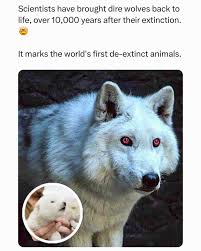Understanding the Extinction of the Dire Wolf

Introduction
The dire wolf, an iconic prehistoric predator, has long captured the imagination of many due to its distinct characteristics and role in ancient ecosystems. As one of the largest canids to have ever existed, the dire wolf thrived during the late Pleistocene era. However, understanding its extinction not only offers insights into the factors that led to the demise of this species but also reflects broader ecological changes that continue to resonate today.
The Rise and Fall of the Dire Wolf
Dire wolves roamed North America around 250,000 years ago, thriving in a diverse array of habitats from grasslands to forests. They were larger than modern wolves, with powerful jaws and a robust build, allowing them to hunt large prey like bison and mammoths. The dire wolf was a crucial member of the ecosystem, participating in complex predator-prey dynamics.
Causes of Extinction
The extinction of the dire wolf is primarily attributed to three interlinked factors: climate change, habitat loss, and competition with other species. As the Earth transitioned into the Holocene period, temperatures rose, and ecosystems changed significantly. The shift from vast Ice Age environments to warmer, drier climates resulted in a reduction of available prey. Consequently, this led to food scarcity for the dire wolves.
In addition to environmental changes, the arrival of other competitors such as the grey wolf, which was more adaptable and versatile, further exacerbated the dire wolf’s decline. Grey wolves migrated south, taking advantage of the changing ecosystem and impacting the dire wolf’s resources. The combination of these pressures ultimately led to the extinction of the dire wolf approximately 10,000 years ago.
Modern Implications
Studying the extinction of the dire wolf provides valuable lessons about sustainability and conservation. As modern ecosystems face similar pressures due to climate change and habitat destruction, understanding past extinctions can help inform current conservation strategies. The dire wolf’s story highlights the importance of genetic diversity and adaptation, making it crucial for current wildlife management efforts.
Conclusion
The extinction of the dire wolf remains a poignant reminder of the fragility of ecosystem balance. It underscores the complex interplay of environmental factors and species interactions that can lead to the decline of a once-dominant predator. As we navigate the challenges posed by climate change today, the lessons learned from the dire wolf’s extinction may guide us in preserving the biodiversity that is vital for the health of our planet.







